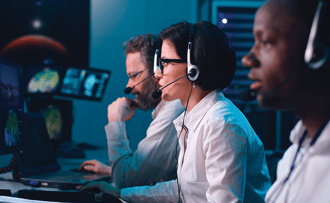Blog
Improve Dispatch Operations with These 911 Dispatcher Training Tips
Emergency responders must react as quickly as possible—community safety depends on it.
But responders cannot be fully prepared to answer emergency calls unless they are provided with proper context and adequate details. The role of dispatch operators is to walk the line between thorough information gathering and rapid dissemination. It is crucial that dispatchers acquire clear context and provide it to emergency responders quickly.
However, there are still dispatch centers across the country using pen and paper to record the important details of emergency calls and flip cards to prompt operator questions. These outdated methods are inadequate. Dispatching centers need to adopt advanced technology—to ensure faster response times, more efficient operations, and ultimately, safer communities.
Improving dispatch operations means evolving with technology—but adapting to this new technology can be difficult. The onboarding and training of 911 dispatchers, both new and old, is often a slow and arduous process.
Investing in proper onboarding is imperative, because there is no room for mistakes. To help you optimize this process, we've outlined a few 911 dispatcher training tips.
Tips for Efficient Onboarding of 911 Dispatchers
1. Teach dispatchers to cope with stress
Dispatching is a high-stress field, but dispatchers need to remain calm so they can gain clarity, especially in life or death situations.
The onboarding process is vital to the success of new dispatchers. Set new operators up to succeed by focusing on essential scripts and procedures, and providing tools that guide them through the process. If dispatchers don't know the procedures by heart, cannot easily navigate through the software, and aren't sure what to say, they're more likely to panic during the call.
With the right computer-aided dispatch (CAD) software, pre-recorded scenarios can be utilized during training to help dispatchers learn how to handle high-stress calls, so they are better prepared to face real calls with a level head.
2. Focus on procedures
Different incidents require different procedures, and it's essential that 911 dispatchers know these procedures by heart. By the time they're onboarded and taking real calls, they shouldn't have to think before they act—what to say, who to call on, and how to handle the situation should be an immediate reaction ingrained in them during the training process.
During the onboarding process, treat software use as one of these necessary procedures. Teach dispatchers about computer-aided dispatch, information input, and software flows to ensure they're working with the software, not against it, to gain the right information and take the right actions.
3. Master information flow
The importance of information flow during a call cannot be overstated. In certain emergency scenarios, the time it takes for first responders to arrive on the scene can make the difference between life or death. Unreliable or inefficient 911 dispatch software that experiences glitches, uses too many screens, or requires too many clicks slows down the dispatch process. 911 dispatch software needs to have a clear and easy-to-use interface for dispatchers to master data input.
So how do you prepare new dispatchers for the tense reality of dealing with emergency situations? By teaching them to master the software's information flow using pre-recorded, faux-call scenarios. Exposure to these simulations will help them adapt to the software and nail down their process.
to better assist responders and help improve the safety of the community.
4. Conduct shadowing with side-along software
Dispatcher shadowing is a standard onboarding practice, because it gives dispatchers room to make mistakes while they're learning—mistakes that could be fatal on a live call. However, this practice lacks an in-the-moment, hands-on element that's necessary for effective onboarding.
The truth of the matter is: dispatchers must be efficient at multitasking under pressure. Maneuvering the software outside the context of a real call has its benefits. But being able to practice their actions and response using the software in real time on a simulated call best prepares dispatchers for the challenges that come with the job.
An ideal solution is having a portal for "side-along" dispatch training where the software looks and works exactly the same as on a live call, but isn't connected to the live radio network. "Side-along" training enables new dispatchers to learn the flow of the software and improve information input. The quicker they can commit the software actions to memory, the more prepared they will be to go live on the radio once onboarding is complete.
Efficient Onboarding for Better Dispatch Operations
Community safety depends on quick response times. As dispatch centers evolve with modern technology, 911 dispatch software becomes faster and more efficient. But this technology is rendered useless if dispatch operators don't evolve with it as well.
Empower your dispatchers with the tools they need to respond to calls calmly, quickly, and confidently. Teach new operators to deal with stress, memorize procedures, and master information flows with training software that mimics live scenarios. By streamlining the onboarding process, you can improve your dispatch center's operations—and ultimately, contribute to a safer community.
More from the blog
View All Posts
How Data Accuracy Can Improve Response Times for Dispatch Coordinators
Read More
4 Essential Features Your Computer-Aided Dispatch (CAD) Software Should Include
Read More
3 Must-Have Dispatch Capabilities You Should Never Be Without
Read MoreSubscribe to email updates
Stay up-to-date on what's happening at this blog and get additional content about the benefits of subscribing.
